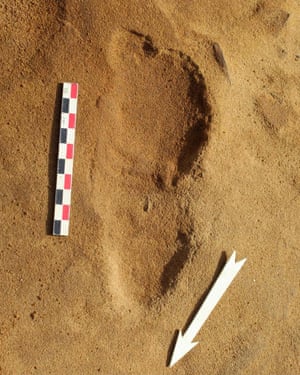Scientists find 257 prints that were preserved in wind-driven sand 80,000 years ago
Source: The Guardian
Scientists have found hundreds of perfectly preserved footprints, providing evidence that Neanderthals walked the Normandy coast in France.
The prints suggest a group of 10-13 individuals, mostly children and adolescents, were on the shoreline 80,000 years ago.
Neanderthals, the closest evolutionary cousins to present-day humans and primates, have long been thought to have lived in social groups, but details have been hard to establish.

The 257 footprints discovered at Le Rozel in western France give a snapshot of how Neanderthals lived and suggest they may have been taller than previously thought.
Jérémy Duveau, a co-author of a study published in the Proceedings of the National Academy of Sciences, said the prints were left in muddy soil and quickly preserved by wind-driven sand.
“It was incredible to observe these tracks, which represent moments in the lives of individuals, sometimes very young, who lived 80,000 years ago,” said Duveau, of the French National Museum of Natural History.
The site was discovered by Yves Roupin, an amateur archaeologist, in the 1960s, but it was not until 2012, when it was threatened by wind and tidal erosion, that government-funded excavations started.
Mechanical diggers were used to extract sand tens of metres down to reach lower layers where the footprints were delicately uncovered with brushes.
The footprints were found among what the team called “abundant archaeological material” revealing evidence of animal butchery and tool-making. They date back to a time when only Neanderthals lived in western Europe.
Neanderthals’ feet were broader than those of modern humans. From the size of the footprints at Le Rozel, the researchers estimated the size of the individuals who made them and then inferred their age.
Some of the prints appear to have been made by a taller individual. Remains of skeletons previously suggested Neanderthals were around 150–160cm tall, but this individual may have measured 175cm (5ft 9in). Quick guide
The Homo sapiens timeline
Rapidly preserved footprints enable archaeologists to better estimate social group sizes than fossilised remains that can accumulate in one site over time. “They record a kind of snapshot into the lives of individuals over a very short period,” Duveau said.
“That gives us some insight into the composition of the group, but it is possible that it represents only those members of the group who happened to be outside at the time.” The findings have raised questions about why there appear to have been so few adults present.
Each of the footprints was photographed and modelled in three dimensions. Casts were taken of a few of them using an elastomer, which is less rigid than plaster. Many of the prints were lifted from the site to be preserved elsewhere.
Those that were not extracted were destroyed by the wind, Duveau said. “The conservation of footprints requires a sort of miracle: we have to get very, very lucky.”
Before Le Rozel, only nine confirmed sets of Neanderthal footprints had been found, in Greece, Romania, Gibraltar and France.
Some of Le Rozel’s casts have already been exhibited, including at the Musée de l’Homme in Paris, and researchers want to find ways to broaden the audience through future exhibits.

































Leave a Comment
You must be logged in to post a comment.